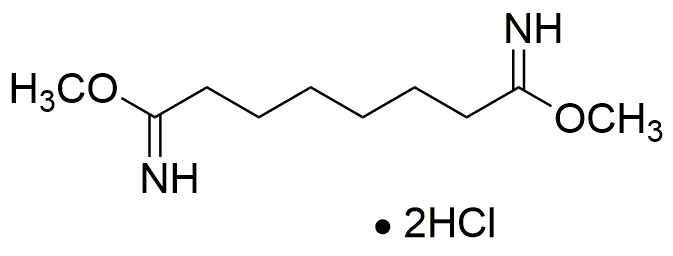Dimethyl suberimidate dihydrochloride is widely utilized in research focused on:
- Protein Cross-Linking: This compound is commonly used to create cross-links between proteins, which is essential in studying protein interactions and structures. It helps researchers understand the functional relationships within complex biological systems.
- Bioconjugation: In the field of biochemistry, it serves as a linker for attaching biomolecules, such as antibodies to drugs or imaging agents. This enhances the specificity and efficacy of therapeutic agents in targeted drug delivery systems.
- Polymer Chemistry: Dimethyl suberimidate dihydrochloride is employed in synthesizing new polymeric materials. Its ability to form stable linkages allows for the development of innovative materials with tailored properties for various applications, including coatings and adhesives.
- Diagnostic Assays: The compound is utilized in the development of diagnostic tests, particularly in immunoassays. By facilitating the attachment of antigens to surfaces, it improves the sensitivity and accuracy of tests for diseases.
- Vaccine Development: In vaccine research, it aids in the formulation of conjugate vaccines by linking polysaccharides to proteins, enhancing immune responses. This application is crucial for developing effective vaccines against various pathogens.
General Information
Properties
Safety and Regulations
Applications
Dimethyl suberimidate dihydrochloride is widely utilized in research focused on:
- Protein Cross-Linking: This compound is commonly used to create cross-links between proteins, which is essential in studying protein interactions and structures. It helps researchers understand the functional relationships within complex biological systems.
- Bioconjugation: In the field of biochemistry, it serves as a linker for attaching biomolecules, such as antibodies to drugs or imaging agents. This enhances the specificity and efficacy of therapeutic agents in targeted drug delivery systems.
- Polymer Chemistry: Dimethyl suberimidate dihydrochloride is employed in synthesizing new polymeric materials. Its ability to form stable linkages allows for the development of innovative materials with tailored properties for various applications, including coatings and adhesives.
- Diagnostic Assays: The compound is utilized in the development of diagnostic tests, particularly in immunoassays. By facilitating the attachment of antigens to surfaces, it improves the sensitivity and accuracy of tests for diseases.
- Vaccine Development: In vaccine research, it aids in the formulation of conjugate vaccines by linking polysaccharides to proteins, enhancing immune responses. This application is crucial for developing effective vaccines against various pathogens.
Documents
Safety Data Sheets (SDS)
The SDS provides comprehensive safety information on handling, storage, and disposal of the product.
Product Specification (PS)
The PS provides a comprehensive breakdown of the product’s properties, including chemical composition, physical state, purity, and storage requirements. It also details acceptable quality ranges and the product's intended applications.
Certificates of Analysis (COA)
Search for Certificates of Analysis (COA) by entering the products Lot Number. Lot and Batch Numbers can be found on a product’s label following the words ‘Lot’ or ‘Batch’.
*Catalog Number
*Lot Number
Certificates Of Origin (COO)
This COO confirms the country where the product was manufactured, and also details the materials and components used in it and whether it is derived from natural, synthetic, or other specific sources. This certificate may be required for customs, trade, and regulatory compliance.
*Catalog Number
*Lot Number
Safety Data Sheets (SDS)
The SDS provides comprehensive safety information on handling, storage, and disposal of the product.
DownloadProduct Specification (PS)
The PS provides a comprehensive breakdown of the product’s properties, including chemical composition, physical state, purity, and storage requirements. It also details acceptable quality ranges and the product's intended applications.
DownloadCertificates of Analysis (COA)
Search for Certificates of Analysis (COA) by entering the products Lot Number. Lot and Batch Numbers can be found on a product’s label following the words ‘Lot’ or ‘Batch’.
*Catalog Number
*Lot Number
Certificates Of Origin (COO)
This COO confirms the country where the product was manufactured, and also details the materials and components used in it and whether it is derived from natural, synthetic, or other specific sources. This certificate may be required for customs, trade, and regulatory compliance.

